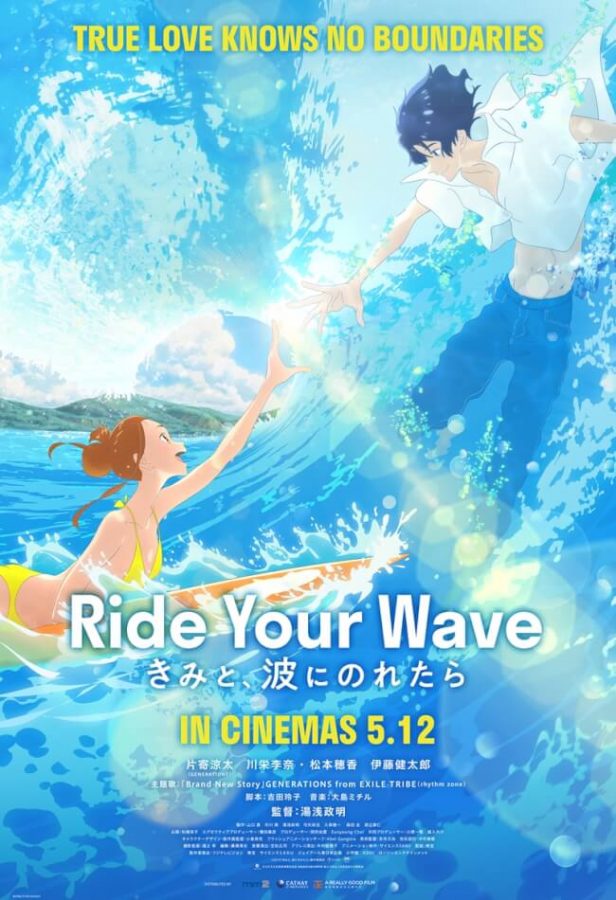Ride Your Wave Review
April 12, 2021
After watching most of Matako Shinkai’s work I have decided to watch a film that particularly piqued my interest, a film by Masaaki Yuasa. Yuasa, a Japanese animator and screenwriter had been involved in many famous works such as Space Dandy, Devilman Crybaby, Samurai Champloo, and unexpectedly the Cartoon Network classic, Adventure Time where he directed the episode “Slow and Steady Wins the Race, Baby.” Not knowing he had been involved in several major works I decided to give one of his most recent films a chance.
Ride Your Wave is a romantic drama that follows 19-year-old Hinako Mukaimizu, a college student that has recently moved to the coast to practice her love for surfing, and Minato Hinageshi, a 21-year-old firefighter who saves Hinako when her apartment had suddenly burst into flames due to the reckless use of fireworks. Through this encounter, Hinako and Minato grow closer through their shared interest in the ocean and waves. Eventually, the two become lovers with a tragic twist as Minato sacrifices his life doing what he does best, being a hero; leaving Hinako to cope with her loss along with rediscovering her purpose in life.
Ride Your Wave had several components throughout the film that had exceeded my expectations. One element that completely elevated this film was its effective use of atmosphere during different sections of the movie. In the film’s exposition, we are first introduced to a comedic atmosphere that contributes to the film’s sense of realism as it depicts Hinako as a clumsy college student taking her first steps into adulthood.
We are then introduced to a very optimistic tone that just gives you that certain feeling that nothing can go wrong, that sort of feeling people generally feel during the youngest stages of love. This section of the film is special to me even now it’s hard to explain exactly what I felt but it made me feel as if I was on top of the world. The film does not have a wide diversity in its musical score but it uses the song “Brand New Story” a single from the band Generations from Exile Tribe. Though this song will serve as the film’s main theme, the song does not fall subject to its repetitiveness as the film uses unique ways to carry the film’s emotion. I love how at one point the voice actors themselves start singing the song in the background which brings this happy-go-lucky atmosphere to life. You can hear the enjoyment in their voices as at some point they start laughing in the middle of singing the song. It makes you feel safe as if nothing can go wrong.
While this song was used to elevate the joyful atmosphere of the play, I found it unique how the same song could have the opposite effect later throughout the film. In fact, it felt like everything prior symbolized this calm before the storm building up to the depressing atmosphere the film later creates. Just the way Hinako sings the song, it’s bleak demonstrating the emotional trauma she has gone through as she is constantly struggling to let go and move on.
Another aspect that elevates the film is its unique animation style. While the animation isn’t of the same quality as Matako Shinkai’s works, the animation has its own personality to it which I enjoyed. In a sense, the animation especially in its character design demonstrates the epitome of beauty in simplicity. When I watched the film the animation gave this sense of freedom to it. While the character designs were generally simple the way they moved was almost enchanting as it reminded me of the calm flow of the ocean at its most peaceful, kind of like that satisfaction you get from watching professional calligraphy as that ink just smoothly flows on a blank canvas. Though most of the film utilized this unique form of animation there were moments of the film where the animation was simply stunning, most memorably the golden-crimson sunset seen setting on the vast ocean.
Lastly, the film effectively utilized other characters through Kawamura Wasabi, a firefighter and a friend of Minato, and Hinageshi Yôko, Minato’s younger sister. Although Wasabi and Yôko both serve as side characters they add a layer of depth throughout the film. During the film, they do their best to comfort Hinako through her grief. By doing this, they magnify the emotional distress Hinako is going through which makes the film feel all the more realistic.
Overall I would consider this film to be a hidden gem as it hasn’t reached the level of popularity as some other Japanese films that have been released in the past few years. Though the film is not rated I would still recommend this film to anyone willing to watch a quality movie. To sum up, everything that has been stated I would rate this film a solid 8.5/10. Don’t miss out on the opportunity and watch Ride Your Wave on Crunchyroll or wherever you watch anime, just don’t forget to bring a box of tissues, it’s an emotional rollercoaster.
